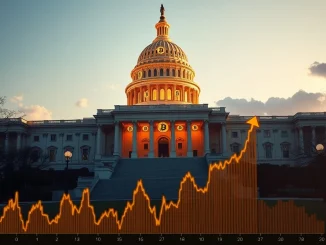
The world of cryptocurrency is no stranger to volatility, but a recent warning from Standard Chartered is capturing significant attention, particularly regarding corporate Bitcoin holdings. These holdings, while representing strong conviction and adding buying pressure in favorable conditions, could become a source of selling pressure under duress. This isn’t just a theoretical concern; it points to a potential systemic risk if the market takes a sharp downturn.
Standard Chartered Bitcoin Analyst Flags Critical Price Level
Geoffrey Kendrick, a seasoned crypto research analyst at Standard Chartered, has highlighted a specific concern: the potential for forced liquidations among companies holding significant amounts of Bitcoin on their balance sheets. His analysis suggests that if the price falls significantly below a company’s average entry cost, they might be compelled to sell to mitigate losses or meet margin calls, especially if these holdings were acquired with leverage or debt.
As of May data, a substantial number of public companies have embraced Bitcoin as a treasury asset. Here’s a quick look at the landscape:
- Approximately 61 public companies currently hold Bitcoin.
- These companies collectively possess about 673,897 BTC.
- This corporate treasury represents roughly 3.2% of Bitcoin’s total circulating supply.
While this demonstrates growing institutional adoption, it also introduces a new variable into market dynamics. The concern arises when considering the average purchase price for these corporate entities.
Understanding the Bitcoin Liquidation Risk Threshold
Kendrick’s warning centers on a critical price threshold relative to the average cost basis of these corporate holdings. He estimates that if the Bitcoin price drops more than 22% below the average entry price for a significant portion of these companies, they could face liquidation pressure. This is the core of the Bitcoin liquidation risk he identifies.
Why 22%? This figure likely relates to typical margin levels or risk management thresholds employed by companies or their lenders. Falling below this level could trigger automated sell-offs or necessitate strategic decisions to unload assets quickly.
The analysis specifically points to a significant portion of these holdings becoming vulnerable if Bitcoin hits a particular price point.
The Critical $90K Bitcoin Price Level
Based on the estimated average entry prices of current corporate holders, Standard Chartered’s analysis indicates that a drop below the $90K Bitcoin price level could put approximately half of these corporate treasuries at risk of forced liquidation. This is a crucial figure for market observers to consider.
Think about the implications:
- A drop below $90K triggers potential selling from a large block of corporate holders.
- This selling pressure could accelerate the existing downward trend.
- Increased selling could push the price down further, potentially triggering more liquidations.
This creates a feedback loop where corporate selling exacerbates the BTC price drop, adding further instability to the market.
What Does a BTC Price Drop Mean for the Market?
While corporate Bitcoin holdings are a sign of maturation for the asset class, their concentration also means that large-scale selling, if triggered, could have a disproportionate impact. Unlike individual investors who might hold through volatility, corporations may face different pressures, including shareholder demands, debt obligations, or accounting rules, which could force their hand during a significant downturn.
The possibility of a cascading effect from corporate liquidations is a scenario worth monitoring. It highlights the interconnectedness of traditional finance and the crypto market as more institutions get involved.
Keeping an Eye on the Horizon
Standard Chartered’s warning serves as a reminder that while institutional adoption brings capital and legitimacy, it also introduces new forms of market risk. Investors and market participants should pay close attention to the average cost basis of major corporate holders (where data is available or estimated) and monitor price levels that could trigger significant selling.
While this analysis points to a potential risk below $90K, it’s important to remember that market dynamics are complex and influenced by numerous factors. However, understanding the potential vulnerabilities of large holders is key to navigating volatile periods.
Summary: Navigating Potential Headwinds
Standard Chartered’s analyst Geoffrey Kendrick has issued a clear warning: the substantial volume of corporate Bitcoin holdings could become a liability rather than an asset if the price falls sharply. Specifically, a drop below the estimated $90K level could trigger forced liquidations among up to half of the current corporate treasuries, representing a significant portion of Bitcoin’s supply. This potential Bitcoin liquidation risk, driven by a substantial BTC price drop, underscores the importance of monitoring key price levels and understanding the different types of market participants. While Standard Chartered Bitcoin analysis provides a specific threshold, the broader takeaway is the need to be aware of potential selling pressure from large institutional holders in a downturn. Staying informed about these dynamics is crucial for anyone involved in the crypto market.



